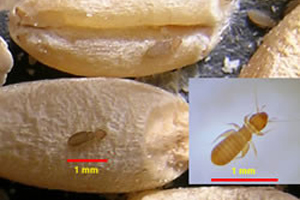Booklice, also called psocids, are not true lice. While they resemble lice in size and shape, booklice feed only on fungi or mold. If you find them in grain or other stored food products, it is an indication of high humidity which encourages mold growth. In addition to food products, psocids may be found under wallpaper, in furniture, along the sides of windows or on window sills around potted plants. Booklice do not bite, transmit disease, or damage food or fabric, but they can be very annoying when present in large numbers.
Biology:
Booklice found inside homes are wingless and very tiny: less than 1/16 of an inch long. While their back legs are thicker than the other four, and resemble the legs found in jumping insects, booklice do not jump, but run about rather quickly.
Adult booklice range in color from translucent white to gray or brown. Females can produce about 60 eggs during the warm summer months and their life cycle (from egg to adult) can be completed in less than one month. When cool temperatures prevail, female booklice produce fewer eggs and the time required to complete their life cycle is over three months. Females deposit their eggs singly and often conceal them by covering with debris. Booklice undergo simple metamorphosis that is their nymphs look just like adults except that they are much smaller and sexually immature. The common house-infesting booklice normally have four nymphal stages.
Injury:
|
Booklice feed on molds and will overrun cereals and similar materials that support mold growth. Their presence, therefore, is a nuisance and can render some foods unfit. The starchy paste of wallpaper and books also can support mold growth or may be attacked directly by booklice. Outside of annoyance, their damage is insignificant. |
 |
Management:
The best way to control booklice is to eliminate moist environmental conditions. Reducing the humidity in your home will eliminate the mold on which the booklice feed. Lowering the relative humidity to less than 50% will prevent their development. An air space under potted plants on windowsills will help keep the humidity down and reduce mold growth. Throw away any infested food material and make sure other foods.

